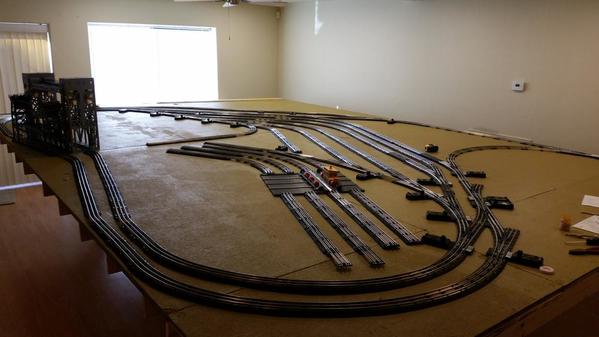Before I start, please let me give a HUGE kudos to Barry Broskowitz on his creation of the DCS O Gauge Companion. This book is absolutely invaluable. I have read, re-read and re-re-read this book and I still find something new and insightful every time I go through it. My hats off to you Barry!
Now...onto my questions. After building many temporary Christmas layout, I am finally building a permanent layout. I've decided long ago that I would use DCS on this layout. My layout is 12 x 18 feet and features several loops along with an upper level reversing loop (please see below).
The vitals of the layout are:
1. Use DCS ( as stated earlier)
2. Use 4 postwar 275 watt ZW transformers with appropriate circuit breaker protection
3. Use 2 TIU's
4. Implement Track Block/Power Districts as recommended in the DCS O Gauge Companion. I chose this approach based on my experience with building Christmas layouts. I learned very quickly that ZW's can get hot quick when running a dual-motor passenger train that is pulling 6 - 8 lit cars! Track Blocks/Power Districts should remedy that problem pronto!5. All switches/accessories will be on their own dedicated ZW (not shown).
The goals of the layout are:
1. Be able to run multiple MTH, TMCC and Conventional engines
2. Run MTH/TMCC and Conventional engines at the same time but on DIFFERENT track loops
3. Be able to run Conventional engines on ANY track loop; not just on a dedicated track loop
4. Not tax any of the transformers.
As I was reading/reviewing the concept of Track Blocks/Power Districts, I thought it prudent to create a diagram of what the wiring for my layout would look like (please see below).
Using the recommended track block length of 5 - 6 track sections (50-to-60 inches) and given the size of the layout, I ended up with 54 Track Blocks assigned to 8 Power Districts (4 ZWs x 2 throttles per ZW). As you can see, I run the 4 ZWs into/through 2 TIUs; utilizing all TIU ports.
And that's when the following questions hit me!
1. If I'm using both the Fixed and Variable ports on the TIUs and one of my goals is to run Conventional engines on any track loop; how do I accommodate for that goal in the wiring? Would I need to acquire 2 more TIUs?
2. I read some where in the Companion that TIU Fixed ports could be changed to Variable ports but do not become true Variable ports; that a MTH add-on for MTH transformers only is required to make them variable by changing voltage at the transformer?
3. Am I over-engineering in regard to the number of Track Blocks? I understand why 5 - 6 track sections is optimal; given the frequency the TIUs use for communicating with the MTH engines. But if I double the track section count for the Track Blocks to 10 - 12 sections; might I be able to take advantage of frequency harmonics (for example high 'C' vs middle 'C' on a musical instrument)?
4. Or maybe I just don't understand the whole concept of "varying track voltage" through the TIU and it's proper implementation?
I am so excited to finally be moving forward on my layout and I hope you can provide some hints or insight into solutions for my questions.
Sincerely,
Junior
PS. If all these topics are already discussed elsewhere in the forum; I would be immensely grateful if someone would point me to them.












